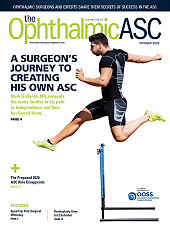At Jacksoneye, our integrated ophthalmology and optometry practice in Lake Villa, Illinois, we’ve seen firsthand how presbyopia drops are transforming the way we initiate care for patients experiencing age-related vision changes. These pharmacologic treatments are more than just a new tool—they’re a strategic entry point into the lifelong care pathway for patients with presbyopia.
Currently, there are 3 presbyopia drops approved by the FDA: Qlosi (pilocarpine hydrochloride ophthalmic solution 0.4%; Orasis Pharmaceuticals), Vuity (pilocarpine hydrochloride ophthalmic solution 1.25%; AbbVie), and VIZZ (aceclidine ophthalmic solution 1.44%; LENZ Therapeutics).
As the first signs of near-vision loss emerge, patients often feel frustrated, confused, or even defeated. But this moment of change is also a powerful opportunity. By offering alternatives to surgery or reading glasses, we can not only address their immediate concerns but also establish a long-term relationship that supports their evolving visual needs.
Meeting Patients at the Start of Their Journey
The ideal candidate for currently available presbyopia drops is typically an early-to-moderate presbyope—someone just noticing difficulty with near-sighted tasks. They are often emmetropic or have low refractive error, and these symptoms mark their first entry into eye care, making them especially eager to avoid invasive options and the perceived stigma of aging that is associated with glasses. Others are contact lens wearers who have never needed vision correction for near work and are now disheartened by the idea of readers.
We also see strong interest from post-LASIK and post-cataract patients, particularly those who regret choosing multifocal intraocular lenses (IOLs). These individuals often expect lifelong freedom from glasses and are surprised when presbyopia sets in. They may mistakenly believe their surgery is “wearing off,” when, in fact, it’s simply the natural aging of the lens. Drops offer a non-surgical solution that aligns with their desire for visual independence.
In all these cases, presbyopia drops serve as a gateway to addressing symptoms without immediately resorting to glasses or surgery. For patients who are hesitant about either, that’s a compelling proposition.
Customization Builds Confidence
One of the most valuable aspects of presbyopia drops is their customizability. Unlike glasses or surgical options, which provide consistent correction but are less adaptable to changing needs, some presbyopia drops provide flexible dosing regimens that can be tailored to a patient’s lifestyle.
For example, Qlosi and Vuity can be administered once or twice daily, as needed, to extend the effect for up to 8 hours. This allows patients to adjust their usage based on work schedules, social events, or specific tasks, offering a personalized alternative to traditional near vision correction.
This flexibility empowers patients. It gives them a sense of control over their vision and helps them feel more engaged in their care. Plus, when patients feel in control, they’re more likely to stay connected to their provider and return for follow-up care.
Setting Expectations
Success with presbyopia drops depends on clear communication and expectation management. We always explain that these drops are not a cure, but a temporary solution for a progressive condition. Patients need to understand that presbyopia will continue to progress, and that future interventions—whether that be glasses or surgery—may eventually be needed.
We also emphasize the importance of neuroadaptation. Some patients expect instant results and may give up after a day or two. Neuroadaptation refers to the brain’s ability to optimize visual processing over time, even when the physical response, like pupil size, remains consistent. The gradual improvement in near vision, often seen between Day 1 and Day 8, is a key reason why we now routinely advise patients to give the drops at least one week, allowing their brain time to adjust. This simple guidance has significantly improved patient satisfaction and retention.
Addressing Aesthetics
There’s also a strong emotional and aesthetic component to presbyopia care. Many patients, especially those who have never worn glasses, see readers as a visible sign of aging. Presbyopia drops offer a discreet alternative.
Whether it’s a professional who doesn’t want to wear glasses during presentations, or a post-LASIK patient who feels betrayed by their changing vision, the desire to maintain a youthful appearance and visual independence is a powerful motivator.
A Foundation for Long-Term Eyecare
What makes presbyopia drops so compelling isn’t just their immediate impact—it’s the foundation they lay for future care. When we introduce drops early, we’re not just solving a problem, we’re starting a conversation. We’re educating patients about the aging process of the eye, the importance of regular exams, and the range of options that will become available as their condition progresses.
This early engagement helps patients understand that presbyopia is not a one-time event, but a journey. And by positioning ourselves as partners in that journey, we build trust and continuity. Importantly, patients who begin their presbyopia care with drops often become more invested in maintaining their visual freedom. When cataracts eventually develop, these patients are more likely to opt for premium IOLs, seeking to preserve the quality of vision they’ve grown accustomed to. This shift in mindset from reactive to proactive can significantly improve long-term outcomes and satisfaction.
Patients who start with a positive early vision-care experience may be more likely to return for follow-ups; more open to future interventions; and more invested in their long-term eye health.
Practical Considerations
Considering adding presbyopia drops to your treatment offerings? A few key steps can make a big difference:
- Educate your staff: Front desk staff and technicians are often the first to hear patients’ frustrations with reading glasses. Ensure they’re informed and confident in discussing drop options.
- Perform thorough evaluations: A dilated retinal exam is essential to rule out contraindications like retinal thinning or detachment.
- Set realistic expectations: Emphasize that drops are functional, not perfect. They may not replace glasses for every task, especially for patients doing detailed near work.
- Encourage commitment: We recommend a 2-month supply.
Overcoming Skepticism
One of the biggest barriers we’ve encountered is residual skepticism from earlier presbyopia drops. Some patients, and even some providers, assume all drops are the same. It’s important to educate both groups on the evolution of these therapies and the improvements in tolerability, duration, and side-effect profiles.
We’ve found that when patients are properly counseled, especially about the need for adaptation and the temporary nature of the solution, they’re far more likely to stay engaged and satisfied.
Conclusion
Ultimately, presbyopia drops are not just a treatment—they’re a strategic entry point into a lifelong care pathway. They allow us to meet patients at the very beginning of their vision changes, offer them a solution that fits their lifestyle, and guide them through the natural progression of presbyopia with confidence and continuity. At the core of what we do, we’re not only offering our patients options to better their eye health—we’re helping them stay engaged, informed, and prepared for what’s next. OM










